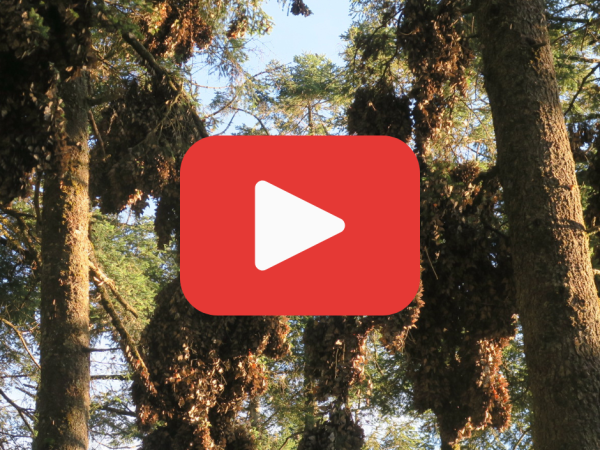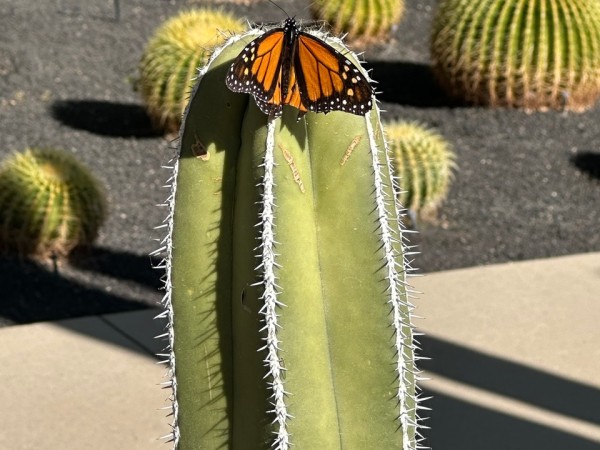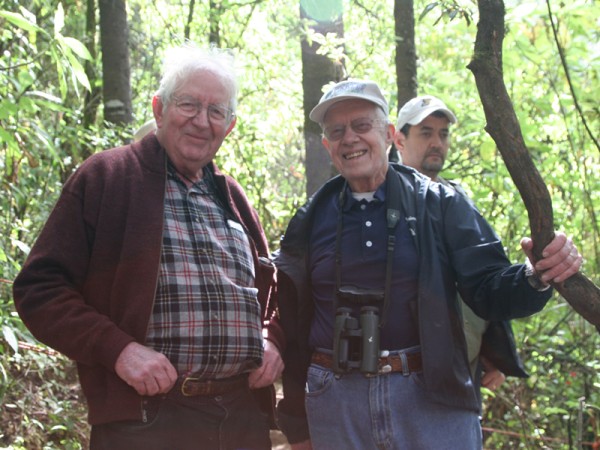Updates from California and Mexico, plus Jimmy Carter's monarch connection
Western monarch update
By Gail Morris, Southwest Monarch Study coordinator
Overwintering monarchs are concentrated in the northern Santa Cruz sites of California this year. While the number of monarchs appears to be very low, there are reports of adult monarchs and larvae in the warmer greater Los Angeles and San Diego areas in California as well as the desert regions of Arizona this year, offering hope.
With the number of overwintering monarchs in Mexico appearing to also be low, it is possible that both California and Mexico are hosting record-low monarch overwintering populations. We are all waiting to hear the final count now, still in progress.
Reports from the field
Seasoned reporters in the field give us a glimpse of monarch activity during the winter season.
Stephanie Turcotte, Pacific Grove Monarch Sanctuary in California
Monarch butterflies overwintering in Pacific Grove responded to a change in weather over the holidays. Stephanie shares her observations visiting the sanctuary.
Dec. 20 – Short but sweet update
This Pacific Grove monarch count report is short and I can say, in a strange way, sweet. We found them all congregated in one eucalyptus, still on the south side of the grove, overhanging into the neighbor’s yard … only a slight shift to the west, in three clusters. There was one loner we found in the east on another eucalyptus, but no other monarchs found singularly nor any on the ground after the strong storm we had last Saturday.
Our count for Dec. 20 is 127 monarchs. It was 48 degrees when we counted; however, the last two days have been exceptionally warm. Yesterday, I saw a single monarch flying west outside the grove about .6 miles away.
Dec. 27 – Lower numbers
We weren’t going to count this week, but I couldn’t help myself. I was curious where and what the small contingent of monarchs did before/after the steady rain we had on Dec. 24. It rained again early this morning too; however, two of us were able to make our way through the periodic drizzle to find them … find some. It took 1.5 hours of carefully searching everywhere and we only found a total of 30 monarchs! The only cluster was a small group of 15 monarchs on Eucalyptus L and a very small group of four on a young eucalyptus inside the grove on the south side. The remainder were loners here and there. We had six grounders, which we haven’t had all season.
There were some very small monarchs. I was able to measure a small male 3.5.
Even in this small group of monarchs we have in Pacific Grove, they show just how strong and resilient they are.
January 4 – Where are they?
Good morning and welcome to 2025!
I had hoped to share some better news for the first monarch update for Pacific Grove in 2025; however, even after searching all over the grove and staring at all the eucalyptus trees overhanging the fence into the neighbor’s yards, we only found six in a loose cluster and one grounder. So the total count for this week is seven monarchs!
It was already 51F when we began scouting. The day prior it was 63F. I observed one monarch gathering nectar in my yard 6/10 of a mile from the grove and then early afternoon another six monarchs flying southwest outside the grove along the old railroad track trail lined with blooming eucalyptus trees. Locals and docents have reported seeing the clusters of 40-50 we had seen before in the eucalyptus lining the fence in the southern end of the grove, but they are not there now.
Fortunately, we keep counting weekly and try to figure out if more are still here and if so, where they might be.
I remain hopeful for a bounce back up.
Diana Magor, Santa Cruz, California
This year the Santa Cruz overwintering sites are hosting the largest population of monarchs, but the numbers are still significantly lower than one year ago. Diana Magor shares the December counts:
A few updates on 3 Santa Cruz overwintering sites: On Dec. 10, I counted 1,478 at LF [Lighthouse Field] (our highest number there so far). On Dec. 12, Beth Bell and John Dayton found only 15 at Natural Bridges.
On Dec. 13, they found 810 at Moran Lake (the highest count this year there). On Dec. 13, we counted 1,303 at Lighthouse Field.
On Dec. 14, there was a large storm, and numbers from both sites plummeted.
On Dec. 14, I counted only 557 at LF.
On Dec. 15, the Moran Lake number was down to 350.
On Dec. 20, our count at LF was 1,250.
Almost all the monarchs at LF have recently been on the west side of an old cypress on the southwest corner of the sanctuary that we refer to as Tree 12. Those branches are protected from the south winds, but not from the west.
The nine clusters there are mostly tightly packed, and they do get the sun in mid to late afternoon. Several move up into the higher branches to get as much sun as possible as the sun recedes and several may be seen flying about trying to settle on a good roosting spot. The weather has been fairly mild, but down into the mid-40s at night. The only major storm so far was on Dec. 14.
Southern California and the Arizona deserts
Despite the low coastal numbers, take a few moments to review the maps of other monarch sightings recently. How often do you see a monarch on a cactus like Susan spotted in Rancho Mirage?
Kenneth Abernathy in Lakeside, California, sent a note to say, “We have lots of native and non-native milkweed still alive, well over 200 larvae and multiple adults, and reports from all over San Diego County of similar.” Then he added, “The warm weather has us booming across the county here, and I have people from Camp Pendleton reporting monarch activity and new larvae!”
Winter monarch reports are important wherever you live, so please do send in your sightings to help us present a balanced report of where monarchs are appearing each week.
Thank you to Stephanie Turcotte and Diana Magor for their reports from the California overwintering sites as well as Kenneth Abernathy in Southern California.
Gail Morris is the coordinator of the Southwest Monarch Study (www.swmonarchs.org). She is also a Monarch Watch conservation specialist, the vice president of the Central Arizona Butterfly Association and sits in several western working groups. The Western Monarch News is based on comments provided to Gail Morris. We hope to increase the number of sightings and therefore photos and comments entered into Journey North. We rely on the volunteers who communicate regularly with Gail and who agree to participate in our effort to increase awareness of the population of western monarchs. You can reach her at gail@swmonarchs.org
An update from Mexico
By Estela Romero for Journey North - Watch Estela's report in video format
North and south from Angangueo valley, the overwintering Oyamel fir forests host the ancestral migration of monarch butterflies to central México in the fall and winter.
The new year begins and encourages the peak of monarchs’ overwintering season. Freezing nights and mornings alternate with bright blue skies during the day, however, January is known as the coldest month of the year and sudden temperature changes to much colder might come after the stable conditions monarchs have had since their arrival last November.
Sierra Chincua
A warm and diligent greeting to visitors, maps and information on our exceptional insect phenomenon provide the best start to an incredible hike in this sanctuary.
Pristine Sierra Chincua colony now changes its distribution to a rather nicely fragmented occupation in its very same location since their arrival last fall. There is no increase in its population now, which does not mean it will not happen later in the season from possible very minor neighboring numbers somewhere around, or portions of neighboring El Rosario or Cerro Pelon might join it.
Local guides in full coordination with authorities, both guarding the reserve, do not speak of the existence of a second colony in Sierra Chincua at this time.
El Rosario
Sanctuary El Rosario welcomes visitors with a nicely renewed display of chronological information on monarchs’ exceptional life cycle, from their breeding lands in North America to their overwintering spots in central México, underlining the uniqueness of habitat conditions and migratory challenges of the second largest migrating phenomenon on Earth.
Over 300 hundred Ejidatario families directly lead and depend on the conservation and tourist activities that the winter miracle encourages in our region among the three largest sanctuaries: Cerro Pelón, Sierra Chincua and El Rosario, of whom around 250, live in El Rosario Ejido.
Hundreds of more families indirectly benefit themselves from the monarchs’ season each winter in the whole region.
El Rosario colony, which traditionally receives up to 50% of the whole migratory population, also continues at its same spot and nearly in identical distribution for a couple of weeks now.
Its still-scattered clusters of medium sizes in well over 100 trees, seen from the limit line to visitors, contrast with heavier, larger clusters at the very core of the colony, making the visit an exceptional experience.
Estela Romero
Journey North
Angangueo, Michoacán, México
- - - - - - - - - - - - - - - - - - - -
Al norte y al sur del valle de Angangueo, los bosques de Oyamel albergan la hibernación de la migración ancestral de las Mariposas monarcas en el Centro de México en el otoño y el invierno.
El año nuevo comienza motivando el pico de la temporada de hibernación de nuestras monarcas. Noches y mañanas heladas alternan con cielos azul profundo durante el día, sin embargo, a Enero le conocemos como el mes más frío del año y pueden ocurrir cambios de clima repentinos a mucho más fríos, después de las condiciones estables que nuestras monarcas han tenido desde su llegada el pasado Noviembre.
Sierra Chincua
Una cálida y diligente bienvenida, mapas e información sobre el fenómeno de nuestro excepcional insecto, brinda el mejor comienzo para una increíble caminata en este Santuario.
La prístina colonia Sierra Chincua cambia su distribución a una mas bien agradable fragmentación en su mismo sitio desde su llegada el pasado Otoño. No se presenta un incremento en su población, lo cual no significa que no ocurrirá más tarde en la temporada, cuando posibles pequeños números a la redonda, o porcentajes de las vecinas El Rosario ó Cerro Pelón, pudieran sumarse a ella.
Los guías locales, en permanente coordinación con las autoridades, ambos en resguardo de la Reserva, no hablan de la existencia de una segunda colonia en Sierra Chincua hasta ahora.
El Rosario
El Santuario El Rosario recibe a sus visitantes con una exhibición cronológica de información excelente sobre el ciclo de vida excepcional de las monarcas, desde sus regiones de reproducción en el norte de América, hasta sus sitios de hibernación en el Centro de México, subrayando la singularidad de su hábitat y retos durante el viaje del segundo fenómeno migratorio más largo del reino animal en la Tierra.
Más de 300 familias de Ejidatarios encabezan y dependen de las actividades turísticas y de conservación que motiva El Milagro de Invierno en toda nuestra región entre los tres más grandes Santuarios: Cerro Pelón, Sierra Chincua y El Rosario, de las que alrededor de 250 de ellas, viven en el Ejido El Rosario.
Cientos de familias más se benefician indirectamente de la temporada de monarcas cada invierno en toda la región.
La Colonia El Rosario que tradicionalmente recibe hasta el 50% de toda la población migratoria, continúa localizada en su mismo sitio y prácticamente con su misma distribución por más de dos semanas al día de hoy. Sus racimos medianos aún esparcidos en más de cien árboles que se aprecian desde la línea limite a los visitantes, contrastan con los grandes y densos racimos en el centro de la colonia, haciendo de la visita una experiencia excepcional.
Estela Romero
Journey North
Angangueo, Michoacán, México
Estela Romero is an environmental educator with Monarchs Across Georgia. Reporting from Angangueo, Michoacán, Estela Romero's work is made possible by funding from Monarchs Across Georgia and the Monarch Butterfly Fund. Estela Romero es educadora ambiental de Monarchs Across Georgia. Informando desde Angangueo, Michoacán, el trabajo de Estela Romero es posible gracias a la financiación de Monarchs Across Georgia y el Monarch Butterfly Fund.
Jimmy Carter's monarch connection
As the world remembers former president Jimmy Carter, who died on Dec. 29, we also looked back on his trip to monarch overwintering sites in Mexico with the late Dr. Lincoln Brower in 2013.
Dr. Brower wrote for Journey North that his February 2013 visit with President Carter was a highlight of his life.
"I had sent him copies of several of our research papers and it was evident that he had carefully read them all," Dr. Brower wrote. "He asked incisive questions and was concerned why the numbers of butterflies are down this year."





